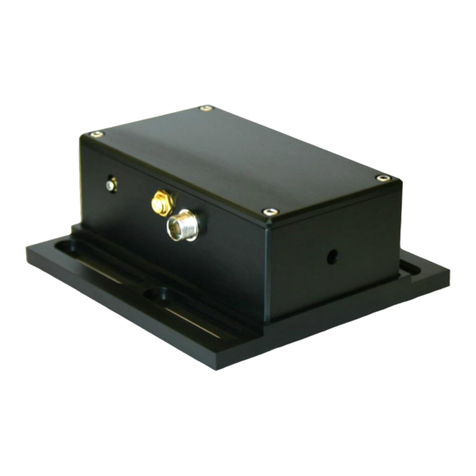
Vescent Photonics D2 Series Product Manual
Optional: For long term frequency stability on side lock, monitor ERROR IN on the oscilloscope,
open up the top of the Spectroscopy Module, and adjust the trimpot such that your desired lock
point crosses 0 on the oscilloscope.
Flip the LOCK MODE switch into the
SIDE LOCK position. The laser will lock
to a positive (upward) slope at the zero
crossing point. If the spot you want to lock
to has a negative slope, flip the GAIN
SIGN switch on the Laser Servo to make
the slope positive. The figure shows the
lockpoint on the DC ERROR signal.
(Note: the GAIN SIGN switch flips the
entire spectrum upsidedown.) Adjust the
DC Offset with the pot tweaker until the
desired lock point is at zero volts.
Adjust the COURSE gain pot to roughly
the number of turns transition you are
locking, shown in the accompanying
paperwork shipped with your laser system. (Turn to left till it clicks, then turn to the right the
specified number of turns.)
Center the spectroscopy such that the lock point is exactly in the center of the oscilloscope. Flip
the lock switch on the right from RAMP to LOCK. The DC error signal should now be reading
0 with visible noise.
Adjust the COURSE and FINE GAIN knob to minimize the noise in the DC ERROR. Too high a
gain usually kicks the laser out of lock or gives rise to sustained oscillations.
Look at the LD OUT monitor. If the value is less than about 50m then the laser successfully
locked to the desired transition. If it is greater then 50m the servo jumped to another lock point
or is railed.
If the laser did not properly lock see the Laser Lock trouble-shooting section () on page .
1. .3. Peak Lock
Note: The laser locks to the point where the DC ERROR crosses zero voltage with a positive
slope and when the oscilloscope is triggering to the RAMP TTL with positive slope.
Adjust the laser current and ramp amplitude so you can clearly see the transition that you want to
lock to.
If not connected, connect one of the short (~1ft) BNC's from RF OUTPUT on the Laser Servo to
the RF INPUT on the Laser Controller. This is the RF dither signal.
Monitor DC ERROR. Flip the LOCK MODE switch to the PEAK position. You should see a
signal that is the derivative of the spectroscopy signal. It may have a large DC offset that you will
have to adjust with the DC Offset trimpot.
Note: The PHASE and DITHER AMP adjustments are factory set. You do not need to adjust
these values.
9




























